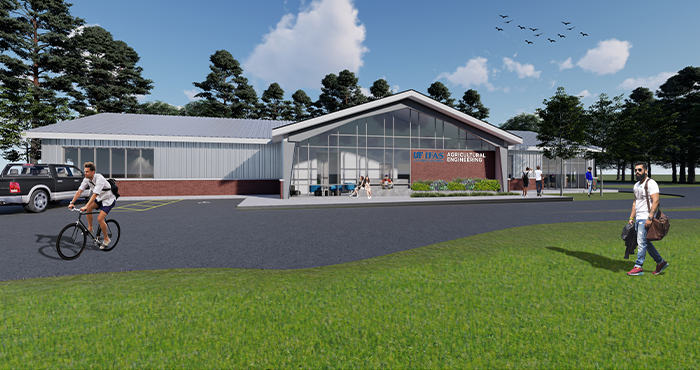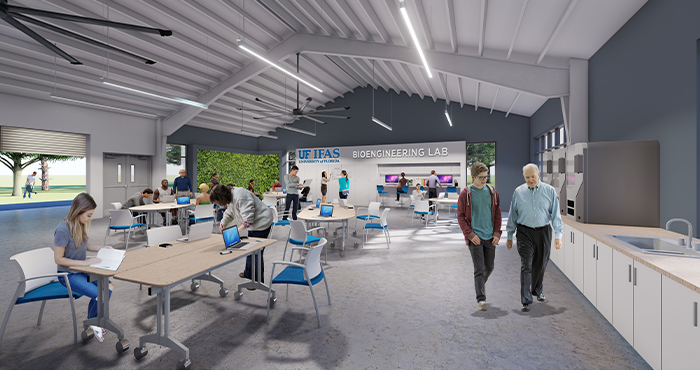The Department of Agricultural and Biological Engineering (ABE) is a key collaborator in the UF/IFAS mission. As we transform into one of the top departments in the nation, we aim to reflect the University of Florida's preeminence goals and Top 10 ranking by increasing undergraduate enrollment and meeting the growing needs of society.
Innovative teaching space is a critical component of our success. As we prepare our students with the best education and ensure they have access to premier programs and equipment, we need to provide the space needed for their growth as successful professionals.
Existing facilities, such as the Agricultural Operations Management (AOM) teaching building, lack the basic elements of a nationally ranked academic institution. The absence of climate control and HVAC systems in addition to obsolete technology, dated design structure, and disrepair does not satisfy the minimal needs of our students. Most nationally ranked ABE departments have designated maker space for students to explore design and other hands-on activities. These spaces provide an environment where students can work as teams, explore multiple applications of engineering electrical, mechanical, hydrologic, etc.- and develop the technical and soft skills that will benefit them as they enter the engineering discipline. Our Agricultural Operations Management (AOM) and Biological Engineering (BE) programs lack this space, and it is a significant limitation to our undergraduate program.
The new teaching space will provide the hands-on experience expected in a top Agricultural and Biological Engineering program. The AOM program includes interdisciplinary, holistic training in agricultural, natural systems, and business management with courses that emphasize hands-on projects. To attract, retain, and develop the best students, there is a need for a teaching building, facilities, and infrastructure that meet the demands of the 21st century. Today’s classes incorporate a wide range of technologies from more traditional machinery and equipment to computers, robotics, sensors. Furthermore, these courses emphasize collaboration and team-based learning.
The experiential learning courses taught in this facility will include collaborative team projects with other IFAS units and Industry partners. The facility will provide a very unique space where students, faculty, other IFAS units, and industry partners can engage in problem identification, solution exploration, and teamwork. This innovative and modern teaching space will provide an ‘apprenticeship’ style learning environment that not only better prepares students for success but also allows their future employers to be part of the process.
The skills that AOM and BE students develop are in high demand yet teaching skills can be effective only to the extent that facilities are available with which to teach desired skills. The individual skills, team-building skills, entrepreneurship, and design innovation such a teaching facility brings will develop workforce-ready students. Job growth in agriculture is expected to grow 6% by 2029 and graduates with a bachelor’s degree in an agricultural discipline can expect a median salary of $65,160 annually (U.S. Department of Labor Bureau of Labor Statistics, 2018). Employers will be receiving students who had access to the latest technologies and tools as well as experience with fundamental building and construction processes.
ABE seeks private funding in the amount of $3M, from a single source or multiple entities, to build a new AOM teaching space and create a new Biological Engineering teaching classroom on campus. The proposed teaching building would consist of two hands-on, experiential learning environments. One classroom would replace the AOM hands-on construction classroom, while the second classroom would provide a much-needed space for BE design. The proposed new building would not only address the basic functionality described, but it would also provide the best teaching equipment to ensure students are prepared to compete and excel in the workforce.
References
U.S. Department of Labor Bureau of Labor Statistics. (2018). Agricultural and Food Scientists: Occupational Outlook Handbook: U.S. Bureau of Labor Statistics. Occupational Outlook Handbook. https://www.bls.gov/ooh/life-physical-and-social-science/agricultural-and-food-scientists.htm
For more information about how you can support this project, please contact:
Kati Migliaccio, Ph.D., P.E.
Dean and Professor
UF/IFAS College of Agricultural and Life Sciences
klwhite@ufl.edu
Greg Kiker, Ph.D.
Interim Chair, Professor, and Graduate Coordinator
UF/IFAS Department of Agricultural and Biological Engineering
gkiker@ufl.edu
Cody Helmer
Executive Director
UF/IFAS Advancement
352-392-5457 | chelmer@ufl.edu





